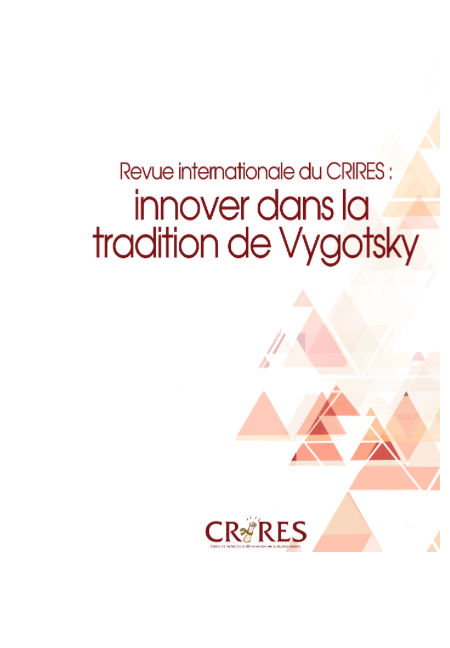Student participation in active learning classrooms as seen through their physical epistemic artifacts
French
DOI:
https://doi.org/10.51657/ric.v6i1.51520Keywords:
Active learning, student engagement, group work, collaboration, knowledge artifactsAbstract
Epistemic artefacts of a physical nature are the material evidence of the work done and produced by students in the course of their learning. According to socio-cultural theory, they can mediate student participation and learning. The role they play, and what this tells us about new forms of teaching such as active learning (AL) in new environments such as active learning classrooms (ALC), had not been explored previously. We used a case study research design and ethnographic methods with 19 instructors from three colleges to explore three research questions based on this gap in the literature. Qualitative coding technique as well as latent class analysis were used to analyse the data, i.e., classroom observations (N=157). Our results confirmed that AL teaching generates physical artefacts. Furthermore, these artefacts play an epistemic role in learning and teaching. Our analyses distinguished four features of these artefacts, expressed as bi-polar modalities: (1) individual and/or collective; (2) private and/or public; (3) analogue and/or digital; and (4) new and/or reused. Other analyses led to more results. It is important to note that the public modality appears to be the most critical for understanding the mediating role of artefacts. We discuss the implications of these public artefacts on how learning and teaching takes place in ALCs and provide suggestions for practitioners using AA pedagogies in ALCs.
References
Bartholomew, D. J., Steele, F., & Moustaki, I. (2008). Analysis of multivariate social science data. CRC press.
Cassidy, R., Charles, E. S., et Slotta, J. D. (2019). Active learning: Theoretical perspectives, empirical studies, and design profiles. Frontiers in ICT, 6, 3. https://doi.org/10.3389/fict.2019.00003
Charles, E., Lenton, K., Dugdale, M., et Lasry, N. (2018). What do real teachers do when they use Active Learning? Presentation at the Association québécoise de pédagogie collégiale (AQPC), June Drummondville, Québec.
Charles, E., Lasry, N., et Whittaker, C. (2013). L’adoption d’environnements sociotechnologiques comme moteur de changement pédagogique. Pédagogie Collégiale (26) 3.
Charles, E.S., Slotta, J.D., Cassidy, R., Dugdale, M., Lenton, K., et Zhang, C. (2019). How Teachers Implement Active Learning: Typologies of orchestrational flow. In 13th International Conference on Computer Supported Collaborative Learning (CSCL) 2019, Volume 1. (pp.448-455). Lyon, France: International Society of the Learning Sciences.
Dillenbourg, P. (2013). Design for classroom orchestration. Computers et Education, 69, 485-492.
Dillenbourg, P., Järvelä, S., et Fischer, F. (2009). The evolution of research on computer-supported collaborative learning. In Technology-enhanced learning (pp. 3-19). Springer, Dordrecht.
Dillenbourg, P., et Jermann, P. (2010). Technology for classroom orchestration. In New science of learning (pp. 525-552). Springer New York.
Dori, Y. J., et Belcher, J. (2005). How does technology-enabled active learning affect undergraduate students' understanding of electromagnetism concepts?. The journal of the learning sciences, 14(2), 243-279.
Freeman, S., Eddy, S. L., McDonough, M., Smith, M. K., Okoroafor, N., Jordt, H., et Wenderoth, M. P. (2014). Active learning increases student performance in science, engineering, and mathematics. Proceedings of the National Academy of Sciences, 111(23), 8410-8415.
Hewitt, J., & Scardamalia, M. (1998). Design principles for distributed knowledge building processes. Educational psychology review, 10(1), 75-96.
Kim, K., Sharma, P., Land, S. M., et Furlong, K. P. (2013). Effects of active learning on enhancing student critical thinking in an undergraduate general science course. Innovative Higher Education, 38(3), 223-235.
Lasry, N., Charles, E.S., et Whittaker, C. (2014). When teacher-centered instructors are assigned to student-centered classrooms. Physical Review Special Topics-Physics Education Research, 2014. 10(1): p. 010116.
Lin, X., Hmelo, C., Kinzer, C. K., et Secules, T. J. (1999). Designing technology to support reflection. Educational Technology Research and Development, 47(3), 43-62.
Linton, D. L., Pangle, W. M., Wyatt, K. H., Powell, K. N., et Sherwood, R. E. (2014). Identifying key features of effective active learning: the effects of writing and peer discussion. CBE-Life Sciences Education, 13(3), 469-477.
Merriam, S. B. (1998). Qualitative Research and Case Study Applications in Education. Revised and Expanded from" Case Study Research in Education.". Jossey-Bass Publishers, 350 Sansome St, San Francisco, CA 94104.
Roschelle, J., et Teasley, S. D. (1995). The construction of shared knowledge in collaborative problem solving. In Computer supported collaborative learning (pp. 69-97). Springer, Berlin, Heidelberg.
Ruiz-Primo, M. A., Briggs, D., Iverson, H., Talbot, R., et Shepard, L. A. (2011). Impact of undergraduate science course innovations on learning. Science, 331(6022), 1269-1270.
Stahl, G. (2000). A model of collaborative knowledge-building. In Fourth international conference of the learning sciences (Vol. 10, pp. 70-77). Mahwah, NJ: Erlbaum, 2000a.
Stahl, G. (Ed.). (2002). Computer support for collaborative learning: Foundations for a CSCL community (CSCL 2002 Proceedings). Psychology Press.
Stahl, G. (2012). Cognizing mediating: Unpacking the entanglement of artifacts with collective minds. International Journal of Computer-Supported Collaborative Learning, 7(2), 187-191.
Teasley, S. D., et Roschelle, J. (1993). Constructing a joint problem space: The computer as a tool for sharing knowledge. Computers as cognitive tools, 229-258.
Theobald, E. J., Hill, M. J., Tran, E., Agrawal, S., Arroyo, E. N., Behling, S., ... et Grummer, J. A. (2020). Active learning narrows achievement gaps for underrepresented students in undergraduate science, technology, engineering, and math. Proceedings of the National Academy of Sciences, 117(12), 6476-6483.
Vermunt, J. K. (2010). Latent Class Models. In E. Baker et B. McGaw (Eds.), International Encyclopedia of Education (pp. 238–244). Oxford: Elsevier.
Vygotsky, L. (1930/1978) Mind in Society. Harvard University Press, Cambridge, MA.
Vygotsky, L. (1934/1986) Thought and Language. MIT Press, Cambridge, MA.
Whittaker, S., Brennan, S. E., et Clark, H. H. (1991, March). Co-ordinating activity: an analysis of interaction in computer-supported co-operative work. In Proceedings of the SIGCHI Conference on Human Factors in Computing Systems (pp. 361-367).
Yin, R. K. (2017). Case study research and applications: Design and methods (6th ed.). Thousand Oaks, CA: Sage Publications.
Downloads
Published
Issue
Section
License
Copyright (c) 2022 Elizabeth Charles, Kevin Lenton, Michael Dugdale, Nathaniel Lasry, Chris Whittaker, Rhys Adams, Chao Zhang

This work is licensed under a Creative Commons Attribution-NonCommercial-NoDerivatives 4.0 International License.

